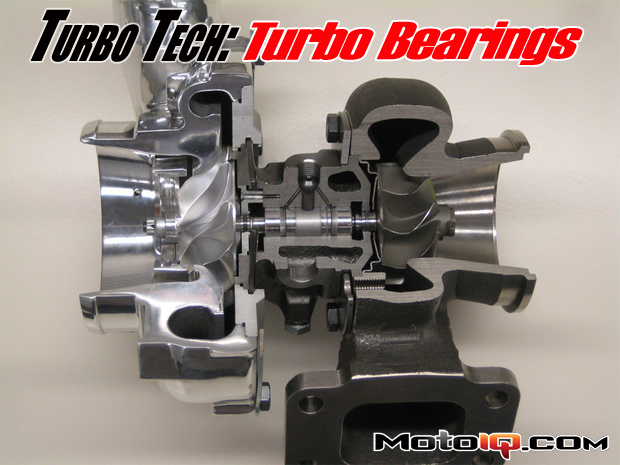,
 |
Here are the parts assembled together. You can see that the thrust collar covers both sides of the thrust bearing. A film of oil goes between the two parts on both sides in order to handle thrust loads in both directions. The spacer keeps the journal bearings located properly. This is a newer method as opposed to older turbos that use C-clips on each side of the journal bearings to keep them in place. |
The other most common type of bearing system used for turbos is the ball bearing system. Ball bearings are a specific type of rolling-element bearing and they work on the principle of the rolling element supporting the load. In a ball bearing, the balls are the rolling element (duh). The most common type of ball bearing used in turbos was pioneered by Garrett and uses what is known as a cartridge bearing. The cartridge bearing consists of two rows of angular contact ball bearings in one assembly to handle both radial and thrust loads. The balls go between a set of inner races and an outer race. This design of bearing system has been used to win pretty much every WRC and LeMans race since the 1990s. As more racing series have gone turbo, more and more racers use ball bearings turbos. Besides the WRC cars and Audi R18 and Peugeot 908 LeMans prototypes, British Touring Car and World Touring Car racers this year are powered by Garrett Motorsports ball bearing turbos.
 |  |
Some generic ball bearings. | A section view representative of the ball bearing cartridge. |
 |
Two examples of ball bearing cartridges used in turbos. |
So the ball bearing system is superior to the journal bearing system as proven in motorsports, but why? In a phrase, power loss. Let’s go back and have a look at the journal bearing system and how it works. For a journal bearing system to work, it has to keep a film of oil between all the spinning parts so that none of them contact each other. This requires a significant volume of oil flow through which all the parts have to spin. Next, there’s the fluid dynamics principle called the no-slip condition. This states that the fluid in contact with a surface does not slide past it.
The film of oil between the shaft and journal bearings is only fractions of a millimeter thick. One side of the film moves with the shaft while the other side stays put with the journal bearing due to the no-slip condition. Imagine this; you have a flat surface with a film of oil only a fraction of a millimeter thick on top. Put a flat plate on top of the oil and move it at 200mph over the flat surface. That’s what the oil sees between the shaft of a turbo and the journal bearing. Shearing the oil like that requires a lot of power!



